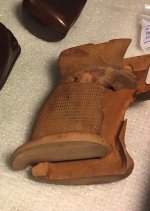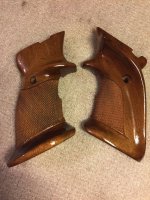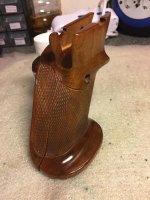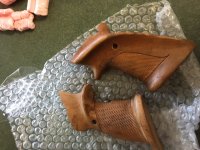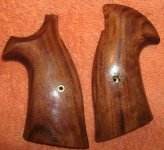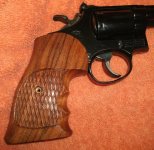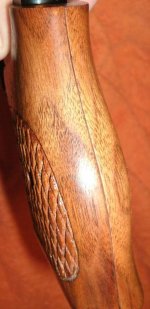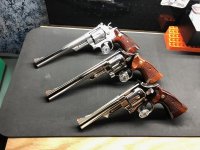Checkering: Apply carefully and with a slightly stiffer brush. Apply sparingly (thin) to avoid thick build-up. 2 coats is usually sufficient.
I would recommend thinning the varnish with oderless mineral spirits (OMS), too, before applying the first coat to both the checkering and the rest of the stock.
Area outside the checkering: Apply 3-4 coats by rubbing on with clean cotton cloth.
I apply the first two coats with a 1000 grit sandpaper (not the checkering obviously), allow it to set for a half minute, then wipe down with clean cloth. For later coats, I use my gloved hand to rub the varnish into the stocks. I will do at least 5 coats. Each coat should cure for at least a day before the next coat. Some people buff the previous coat with fine steel wool or really high grit paper (4000) with a wipe down before the next coat.
There's a tung oil saying that applies: one coat a day for a week, then one coat a week for a month, then one coat a month for a year, then one coat a year for the rest of your life. I don't go that far, but I do like a final coat after a week's cure. Then I wait another week and apply paste wax.
Soaking the grips for a few hours in acetone followed by scrubbing with a toothbrush will remove the old finish.
I recommend avoiding acetone if at all possible. It is very tough on the wood. Use a stripper (I use citrus strip mostly). If there is oil soaked into the wood, you can first try soaking in OMS before acetone. Note that OMS will take a long time to dry out of the stock after soaking, like a few days. I normally heat the stocks up in the oven to ~ 140 degrees for a half an hour before starting on the first coat, to ensure that as much water as possible is removed from the stocks before the varnish seals the wood.
Allow the grips to completely dry and then minimal sanding with 240 -320 grit sand paper to sufficiently smooth the surface followed by a wipe down to get the dust off and you're ready for the Birchwood Casey TruOil application
Stress here the minimal part. The less sanding you can do, the better. If I can get away with it, I start with 400 grit paper, then go to 800 grit, then use 1000 grit with the first coat, wiping the slurry of varnish and dust into the grain, then wiping the excess off.
Attached is a pair of Ahrend k-frames and a unknown cheap pair I refinished (mustang?).


